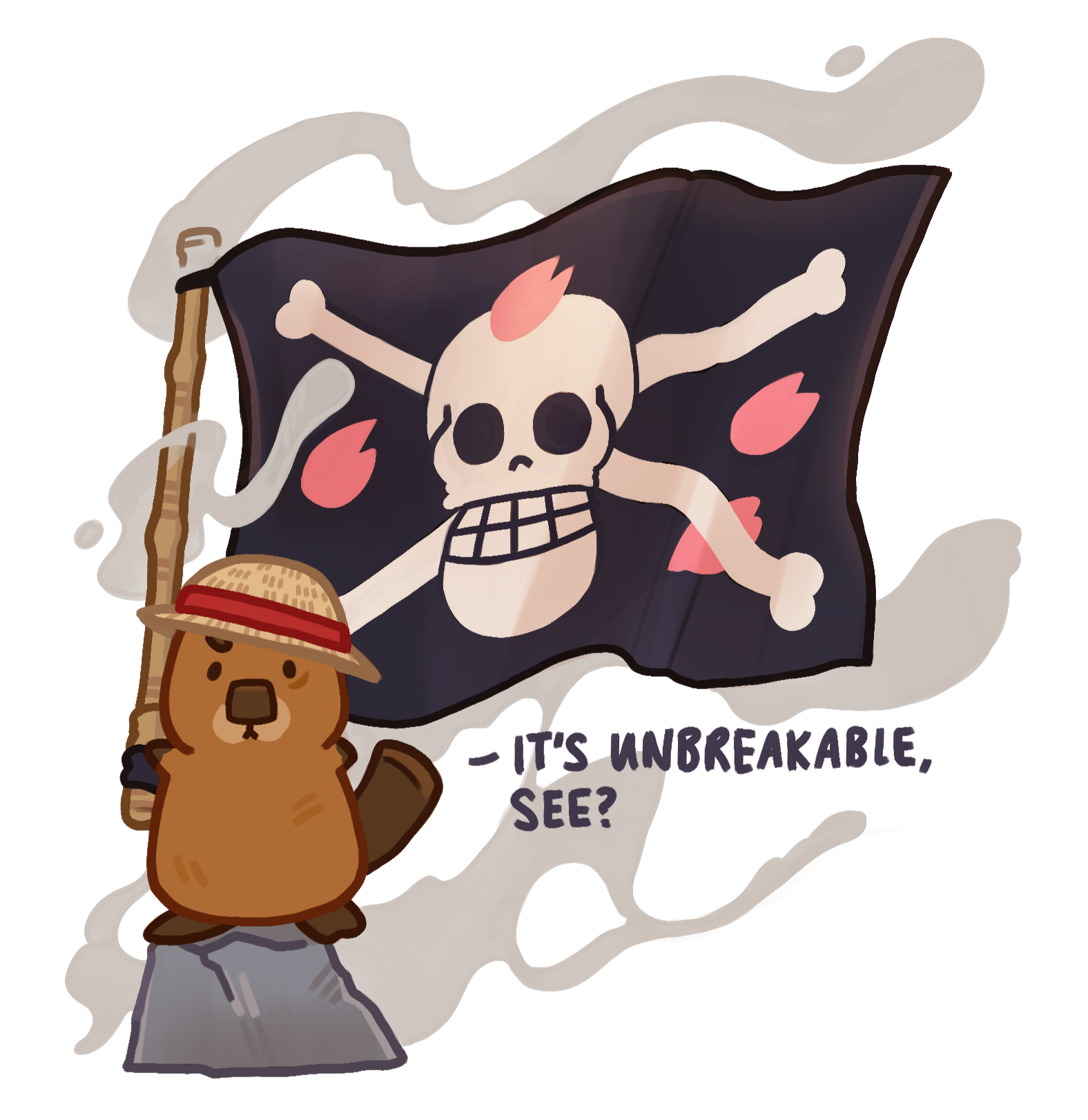By Lucas Ngai
Illustrated by Sylvain Chan
I never really understood the appeal of pirates – never watched Peter Pan, never watched Pirates of the Caribbean, never played with those pirate Lego sets, simply because I didn’t feel like it, and they just looked weird to me. My knowledge of pirates only consisted of the Pirates of the Caribbean orchestral theme I played in middle school and, well, the BTD Monkey Buccaneer.
Yet this summer – by complete coincidence – I interned at the ‘Literacy Pirates’, a charity which helps children falling behind in class to develop confidence in reading and writing. And then…I ‘caught up’ with 1120+ chapters of One Piece (a questionable life decision that I have no regrets making whatsoever).
While I wholeheartedly enjoyed my time doing both things, I sometimes found myself struggling to suspend my disbelief. Real pirates do terrible things, don’t they? The Maersk Alabama hijacking orchestrated by the Somali pirates quickly comes to mind. And you can’t forget the Vikings, whose legacy is stained with murder, pillage, and rape. If we want to be a positive influence on kids, why is such a morally dubious medium so permissible? After all, both the Literacy Pirates and One Piece have audiences of young, impressionable children.
Maybe it really isn’t that deep – the pirate story was literally made for children! One of the most influential pieces of pirate literature, Treasure Island, was created because Robert Stevenson needed to entertain his 12-year-old stepson. It follows the coming-of-age of Jim Hawkins, a young boy who gets swept up in a fight for buried treasure between Squire Trelawney and the antagonist Long John Silver, a strong and charismatic character (disguised as a peg-legged cook) who nearly wins over Jim’s trust. The story is often credited with establishing the “X-marks-the-spot”, tropical islands, buried treasure, and parrots as defining features of the pirate trope.
But still, to go from a stinky plunderer, murderer, and womaniser to swashbuckling, treasure-burying, eyepatch-donning, rum-guzzling, deliciously illicit buccaneer is quite the stretch. How the hell did we even get here?
To put it simply: first, the ‘Golden Age of Piracy’ during the late 17th to early 18th century, and second, 19th century Romanticism. When the British, French, and Dutch vied for power in the New World over the Spanish, piracy flourished as the European powers made deals with the devil, so to speak. This came in the form of ‘letters of marque’, which legally sanctioned pirates (now privateers) to plunder their rivals’ ships and keep whatever they found as payment. As pirate activity from both state and non-state actors grew, many of them eventually established a safe haven at Port Royal in Jamaica, while others went to plunder the Indian Ocean trade routes.
It is worth noting that discerning what actually happened in this era is quite difficult. The go-to pirate history book, A General History of the Pyrates (AGH), contradicts colonial government records in multiple accounts, but also contains multiple grains of truth. To add fuel to the fire, it is this frustratingly elusive AGH that spawned the wealth of pirate literature in 19th century Romanticism writing, including Lord Byron’s The Corsair and Stevenson’s Treasure Island. To me however, it is these grains of truth, these social commentaries which ultimately lend themselves to the pirate’s longevity in popular culture.
So what exactly is there to romanticise?
While they were probably uninterested in highbrow discussions of abstract ideas, many ideals that pirates stood for (and depicted to have stood for) are actually different to, and sometimes ahead of, the status quo. A likely reason for AGH’s success is the intellectual context of the Enlightenment, where pirates’ opposition to the ancien regime – that is, a highly stratified, socially immobile, and wholly corrupt society – was societally permissible. Pirates spearheaded the ideal of social mobility, and even abolitionism (a century before it gained traction in the Antebellum era!). A most extreme example can be seen in AGH’s account of Captain James Misson who founded Libertalia, a utopian society in Madagascar that was anti-slavery, free, and equal for every colour and creed.
Although Misson and his utopia are most likely fictional, piracy’s appeal of social mobility is rooted in reality. The economic impetus of the 17th and 18th centuries made piracy an attractive prospect, especially for the lowest strata of society with nothing to lose. This came in the form of the Navigation Acts: as Britain restricted the American colonies’ trade with other colonies, American demand for goods from the Spanish and French remained. As a result, the incentive for plundering other European ships and smuggling their goods became ever more compelling. Funnily enough, the congregation of people who found piracy appealing also made pirate crews extremely diverse: rarely in other scenarios would one find runaway slaves, Dutch, Portuguese, French, and Englishmen co-existing and cooperating with each other to the extent they did. In this way, pirates championed racial mobility as well.
Another way that pirates’ countercultural ideals manifested themselves is through the ‘Pirate Code’. Before a member was inducted into the fold, they had to swear on the Bible to follow a set of rules agreed upon by the crew. These varied from ship to ship, but a few rules of thumb hold. Firstly, all plunder gained was separated into equal shares. Each member’s share is determined by their rank within the crew, alongside the principle “no prey, no pay”; each pirate was entitled to the relative contribution they made to the plunder. In this way, pirates were surprisingly fair, even meritocratic compared to their contemporaries. Additionally, the captain never held absolute power over the ship: their power was always checked by their crewmates, and could be voted off if they weren’t doing a good job. Suffice to say, it isn’t a surprise that these contrarian, democratic ideas which pirates represented both in history and fiction aptly embodied the anti-establishment zeitgeist of the Romantic era.
It is intriguing how these ideas continue to find solace in readers over two centuries later. Perhaps it speaks to our innate desire to go against the blatant systemic flaws in our society, however imperfect yet realistic the means may be. Take One Piece, which contains many of the contrarian ideas and social commentary that captured the imaginations of people centuries prior. In it, Luffy (the protagonist) and his diverse crew of Straw Hat pirates not only face conflicts with others trying to find the ‘One Piece’ on the Grand Line, but also face injustices rooted in the real-world, such as slavery, racism, and censorship. At the core of the conflict is the corrupt World Government (who ironically wear capes with ‘JUSTICE’ plastered on them), who try to stop Luffy from getting the ‘One Piece’. Throughout the story one can see his attitude toward systemic injustice turn from simple naïvety to a nuanced optimism, as he overcomes his own emotional struggles throughout the story.
In a sense, our modern world is not so different from the 18th century or the Grand Line. Generational wealth continues to accumulate. Inequality is on the rise. Many of us tire of our societal obligations to fully subscribe to the orthodoxy of our era. So if somebody like Luffy is able to raise his proverbial (rubber) middle finger in the face of those circumstances with such indomitable will, it is easy to see why us readers of all ages – for posterity – will gladly stand with him until the end of time.






